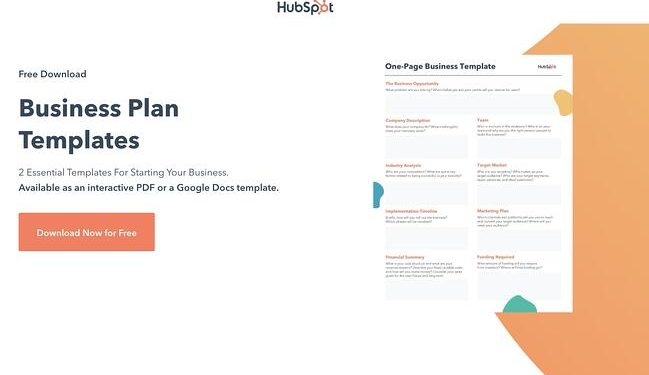Ask any successful sports coach how they win so many games, and they’ll tell you they have a unique plan for every single game. The same logic applies to business. If you want to build a thriving company that can pull ahead of the competition, you need to prepare for battle before breaking into a market.
Business plans guide you along the rocky journey of growing a company. Referencing one will keep you on the path toward success. And if your business plan is compelling enough, it can also convince investors to give you funding.
What does a business plan look like? And how do you write one that is viable and convincing? Let’s review the business plan format and sample business plans you can use to inspire your own.
Business Plan Format
Before you start your business plan, you might be wondering, “Where do I start? How should I format this?”
Typically, a business plan is a document that will detail how a company will achieve its goals.
Most business plans include the following sections:
1. Executive Summary
The executive summary is arguably the most important section of the entire business plan. Essentially, it’s the overview or introduction, written in a way to grab readers’ attention and guide them through the rest of the business plan (which may be dozens or hundreds of pages long).
Most executive summaries include:
- Mission statement
- Company history and leadership
- Competitive advantage overview
- Financial projections
- Company goals
However, many of these topics will be covered in more detail later on in the business plan, so keep the executive summary clear and brief, including only the most important take-aways.
If you’re planning to start or expand a small business, preparing a business plan is still very crucial. The plan should include all the major factors of your business. You can check out this small business pdf to get an idea of how to create one for your business.
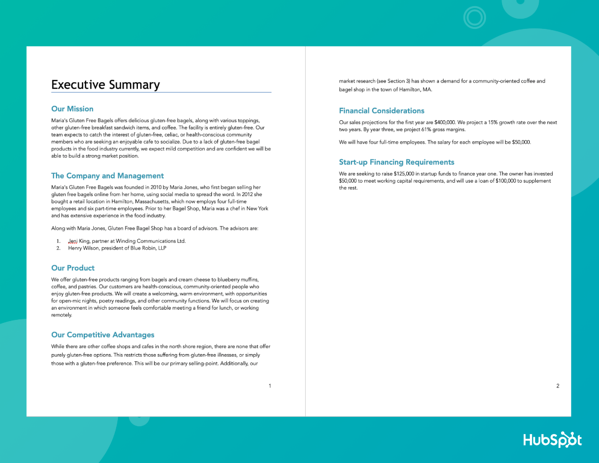
Check out our tips for writing an effective executive summary for more guidance.
2. Market Opportunity
This is where you’ll detail the opportunity in the market. Where is the gap in the current industry, and how will your product fill that gap?
In this section, you might include:
- The size of the market
- Current or potential market share
- Trends in the industry and consumer behavior
- Where the gap is
- What caused the gap
- How you intend to fill it
To get a thorough understanding of the market opportunity, you’ll want to conduct a TAM, SAM, and SOM analysis and perform market research on your industry. You may also benefit from creating a SWOT analysis to identify some of the insights for this section.
3. Competitive Landscape
Speaking of market share, you’ll need to create a section that shares details on who the top competitors are. After all, your customers likely have more than one provider to choose from, and you’ll want to understand exactly why they might choose one over another. Performing a competitive analysis can help you uncover:
- Industry trends that other providers may not be utilizing
- Strengths in your competition that may be obstacles to handle
- Weaknesses in your competition that may help you develop selling points
- The unique proposition you bring to the market that may resonate with customers
4. Target Audience
This section will describe who your customer segments are in detail. What is the demographic and psychographic information of your audience?
If your immediate answer is “everyone,” you’ll need to dig deeper. Ask yourself:
- What demographics will most likely need/buy your product or service?
- What are the psychographics of this audience? (Desires, triggering events, etc.)
- Why are your offerings valuable to them?
It can be helpful to build a buyer persona to get in the mindset of your ideal customers and be crystal clear on why you’re targeting them.
5. Marketing Strategy
Here, you’ll discuss how you’ll acquire new customers with your marketing strategy. You might consider including information on:
- The brand positioning vision and how you’ll cultivate it
- The goal targets you aim to achieve
- The metrics you’ll use to measure success
- The channels and distribution tactics you’ll use
It can help to already have a marketing plan built out to help you inform this component of your business plan.
6. Key Features and Benefits
At some point in your business plan, you’ll review the key features and benefits of your products and/or services. Laying these out can give readers an idea of how you’re positioning yourself in the market and the messaging you’re likely to use. It can even help them gain better insight into your business model.
7. Pricing and Revenue
This is where you’ll discuss your cost structure and various revenue streams. Your pricing strategy must be solid enough to turn a profit while staying competitive in the industry. For this reason, you might outline:
- The specific pricing breakdowns per product or service
- Why your pricing is higher or lower than your competition’s
- (If higher) Why customers would be willing to pay more
- (If lower) How you’re able to offer your products or services at a lower cost
- When you expect to break even, what margins do you expect, etc?
8. Financials
This section is particularly informative for investors and leadership teams to determine funding strategies, investment opportunities, etc. According to Forbes, you’ll want to include three main things:
- Profit/Loss Statement – This answers the question of whether your business is currently profitable.
- Cash Flow Statement – This details exactly how much cash is incoming and outgoing to provide insight into how much cash a business has on hand.
- Balance Sheet – This outlines assets, liabilities, and equity, which gives insight into how much a business is worth.
While some business plans might include more or less information, these are the key details you’ll want to include.
Keep in mind that each of these sections will be formatted differently. Some may be in paragraph format, while others will be in charts.
Sample Business Plan Templates
Now that you know what’s included and how to format a business plan, let’s review some templates.
1. HubSpot’s One-Page Business Plan
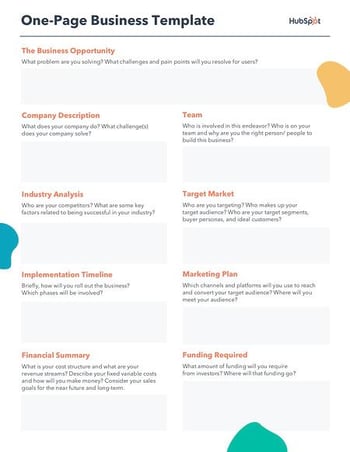
Download a free, editable one-page business plan template.
The business plan linked above was created here at HubSpot and is perfect for businesses of any size – no matter how many strategies we still have to develop.
Fields such as Company Description, Required Funding, and Implementation Timeline gives this one-page business plan a framework for how to build our brand and what tasks to keep track of as we grow. Then, as the business matures, it can expand on its original business plan with a new iteration of the above document.
2. HubSpot’s Downloadable Business Plan Template
We created a business plan template for entrepreneurs.
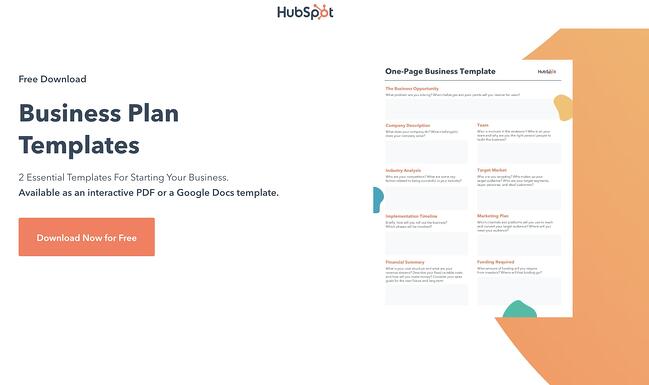
Download a free, editable one-page business plan template.
The template is designed as a guide and checklist for starting your own business. You’ll learn what to include in each section of your business plan and how to do it. There’s also a list for you to check off when you finish each section of your business plan.
Strong game plans help coaches win games and help businesses rocket to the top of their industries. So if you dedicate the time and effort required to write a viable and convincing business plan, you’ll boost your chances of success and even dominance in your market.
3. LiveFlow’s Financial Planning Template with built-in automation
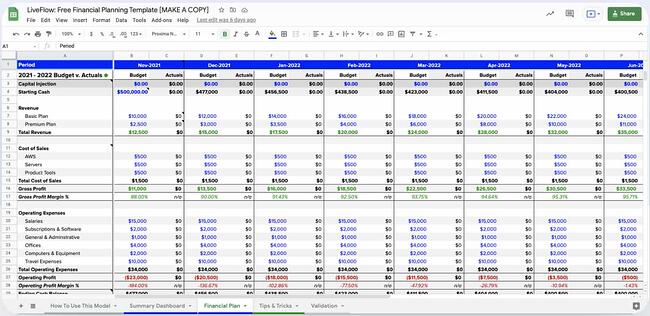
This free template from LiveFlow aims to make it easy for businesses to create a financial plan and track their progress on a monthly basis. The P&L Budget versus Actual format allows users to track their revenue, cost of sales, operating expenses, operating profit margin, net profit, and more.
The summary dashboard aggregates all of the data put into the financial plan sheet and will automatically update when changes are made. Instead of wasting hours manually importing your data to your spreadsheet, LiveFlow can also help you to automatically connect your accounting and banking data directly to your spreadsheet, so your numbers are always up-to-date.
With the dashboard, you can view your runway, cash balance, burn rate, gross margins, and other metrics. Having a simple way to track everything in one place will make it easier to complete the financials section of your business plan.
4. ThoughtCo’s Sample Business Plan
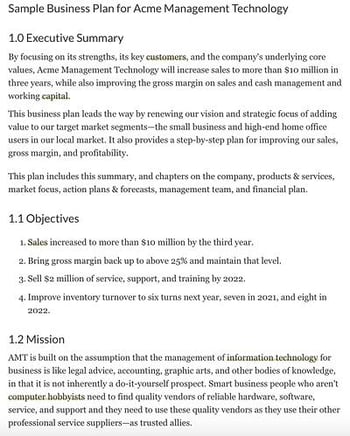
If you want to reference an actual business plan while writing your own, ThoughtCo’s got you covered. It created a fictional company called Acme Management Technology and wrote an entire business plan for it.
Using its sample business plan as a guide while filling out your own will help you catch and include small yet important details in your business plan that you otherwise might not have noticed.
5. BPlan’s Free Business Plan Template
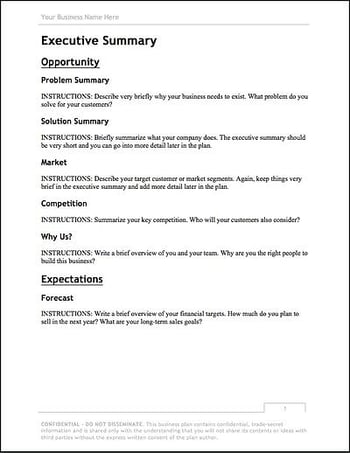
One of the more financially oriented sample business plans in this list, BPlan’s free business plan template dedicates many of its pages to your business’ financial plan and financial statements.
After filling this business plan out, your company will truly understand its financial health and the steps you need to take to maintain or improve it.
6. Harvard Business Review’s “How to Write a Winning Business Plan”
Most sample business plans teach you what to include in your business plan, but this Harvard Business Review article will take your business plan to the next level – it teaches you the why and how behind writing a business plan.
With the guidance of Stanley Rich and Richard Gumpert, co-authors of “Business Plans That Win: Lessons From the MIT Enterprise Forum”, you’ll learn how to write a convincing business plan that emphasizes the market demand for your product or service. You’ll also learn the financial benefits investors can reap from putting money into your venture rather than trying to sell them on how great your product or service is.
7. HubSpot’s Complete Guide to Starting a Business
If you’re an entrepreneur, you know writing a business plan is one of the most challenging first steps to starting a business. Fortunately, with HubSpot’s comprehensive guide to starting a business, you’ll learn how to map out all the details of your business by understanding what to include in your business plan and why it’s important to include them. The guide also fleshes out an entire sample business plan for you.
If you need further guidance on starting a business, HubSpot’s guide can teach you how to make your business legal, choose and register your business name, and fund your business. It will also give small business tax information and provide marketing, sales, and service tips.
8. Panda Doc’s Free Business Plan Template
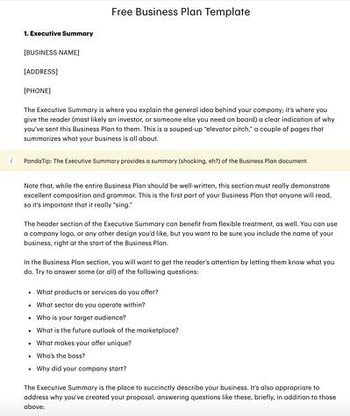
Panda Doc’s free business plan template is one of the more detailed and fleshed-out sample business plans on this list. It describes what you should include in each section, so you don’t have to come up with everything from scratch.
Once you fill it out, you’ll fully understand your business’ nitty-gritty details and how all of its moving parts should work together to contribute to its success.
9. Small Business Administration Free Business Plan Template
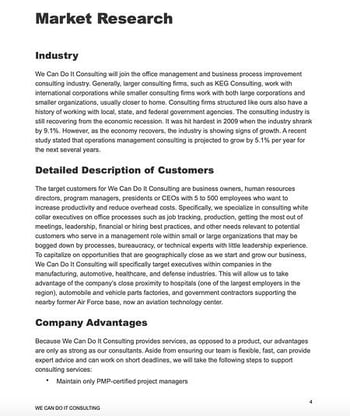
The Small Business Administration (SBA) offers several free business plan templates that can be used to inspire your own plan. Before you get started, you can decide what type of business plan you need — a traditional or lean start-up plan.
Then, you can review the format for both of those plans and view examples of what they might look like.
10. Culina Sample Business Plan
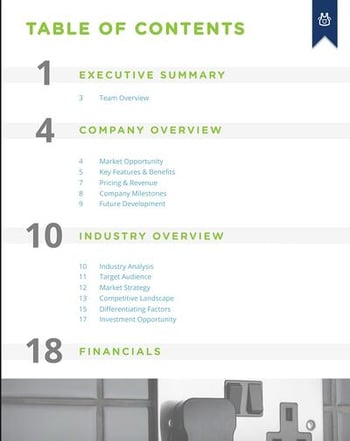
Culina’s sample business plan is a great template to use if you just want to fill in your information. You can also use this template as a guide while you’re gathering important details. After looking at this sample, you’ll have a better understanding of the data and research you need to do for your own business plan.
11. Plum Sample Business Plan
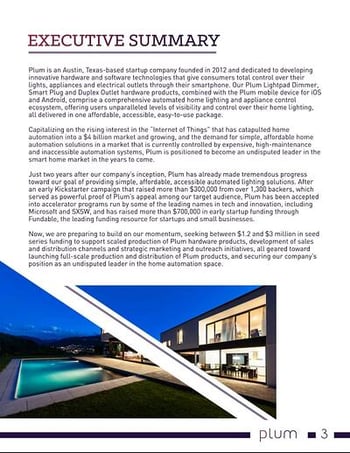
This is one of my favorite sample business plans because you can see how implementing visuals can help tell your brand’s story. The images in this template are cutting edge, which makes sense for an innovative company like Plum. When creating your own business plan, make sure the pictures and design you use make sense for your branding.
Additionally, the financial charts included are incredibly helpful if you’re not sure what financial information to include.
12. LiveShopBuy Sample Business Plan
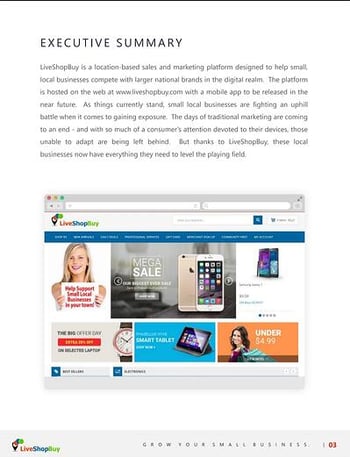
With this business plan, the focus is the investment opportunity. This is an excellent template to use if you’re going to use your business plan to receive funding. The investment opportunity section is placed right up front and is several pages long. Then, it goes into more detail about the company synopsis industry analysis.
Top Business Plan Examples
Here are some completed business plan samples to get an idea of how to customize a plan for your business. We’ve chosen different types of business plan ideas to expand your imagination. Some are extensive, while others are fairly simple.
Take a look.
1. LiveFlow
One of the major business expenses is marketing. How you handle your marketing reflects your company’s revenue. We included this business plan to show you how you can ensure your marketing team is aligned with your overall business plan to get results. The plan also shows you how to track even the smallest metrics of your campaigns, like ROI and payback period instead of just focusing on big metrics like gross and revenue.
Fintech startup, LiveFlow, allows users to sync real-time data from its accounting services, payment platforms, and banks into custom reports. This eliminates the task of pulling reports together manually, saving teams time and helping automate workflows.
When it came to including marketing strategy into its business plan, LiveFlow created a separate marketing profit and loss statement (P&L) to track how well the company was doing with its marketing initiatives. This is a great approach, allowing businesses to focus on where their marketing dollars are making the most impact.
“Using this framework over a traditional marketing plan will help you set a profitable marketing strategy taking things like CAC, LTV, Payback period, and P&L into consideration, “ explains LiveFlow co-founder, Lasse Kalkar.
Having this information handy will enable you to build out your business plan’s marketing section with confidence. LiveFlow has shared the template here. You can test it for yourself.
2. Lula Body
This is a good business plan example for service-based businesses such as gyms, boxing, dancing classes, etc. For starters, the plan shows how to budget for the business loan and what to focus on buying first. Everything is well presented, including what to charge the customers in different scenarios and the expected revenue. This is a good foundation from which business performance can be evaluated with time.
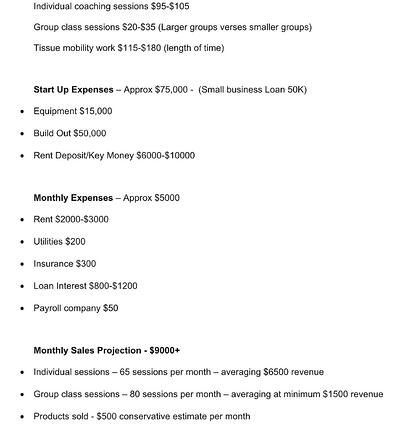
Brooklyn Business owner and Pilates instructor, Tara Kashyap, saw a need in her community for a pilates, tissue, and bodywork studio. In response, she opened Lula Body in Crown Heights.
Pictured above is a hypothetical pricing and revenue statement based on Lula Body’s business plan. As you can see, Kashyap breaks down the cost of classes, start-up expenses, monthly expenses, and her monthly sales projection. Everything from equipment costs to loan interest is included in the expenses to give the most accurate picture of operating costs and revenue.
If you’re seeking outside funding for your business, you’ll want to make sure this section of your business plan is as thorough as possible.
3. Patagonia
Sometimes all you need is a solid mission statement and core value to guide you on how to go about everything. You do this by creating a business plan revolving around how to fulfill your statement best. For example, Patagonia is an eco-friendly company, so their plan discusses how to make the best environment-friendly product without causing harm.

A good mission statement should not only resonate with consumers but should also serve as a core value compass for employees as well.
Outdoor clothing retailer, Patagonia, has one of the most compelling mission statements we’ve seen:
“We’re in business to save our home planet.”
It reels you in right from the start, and the environmental-friendly theme continues throughout the rest of their statement.
The page-length open letter goes on to explain that they are out to “Build the best product, cause no unnecessary harm, and use business to protect nature.”
Their mission statement is compelling and detailed, with each section outlining how they will accomplish their goal.
4. Vesta Home Automation
This is the kind of business plan you need when applying for business funds. It clearly illustrates the expected future of the company and how the business has been coming along over the years.
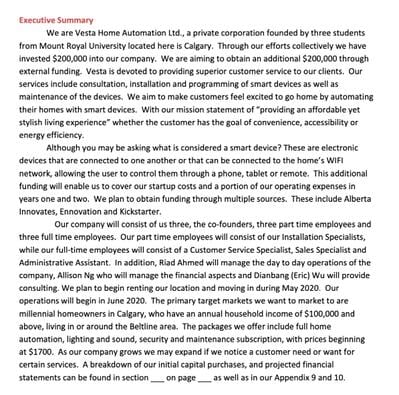
This executive summary for a smart home device startup is part of a business plan created by students at Mount Royal University. While it lacks some of the sleek visuals of the templates above, its executive summary does a great job of demonstrating how invested they are in the business.
Right away, they mention they’ve invested $200,000 into the company already, which shows investors they have skin in the game and aren’t just looking for someone else to foot the bill.
Get Started Writing Your Business Plan
When you’re first getting started on your business plan, it can be daunting. The business world moves fast, and it’s full of ambitious companies scrambling to gain the majority of their industry’s market share.
That’s why it’s important to make sure you understand the value your business provides and can communicate that through a properly formatted business plan.
Editor’s note: This post was originally published in November 2018 and has been updated for comprehensiveness.
Source by blog.hubspot.com
